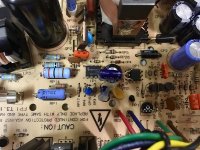RodCastler
Member
Hi all,
Thanks to the valuable material found on these forums I have been able to *almost* liberate my mac classic.
Looking for the source of the voltage drop at both 12V and 5V rails, I began with the routinary full re-cap of the leaky ones.
Finally, after replacing the mosfet, the mosfet driver, the opto-isolator and *every* electrolytic cap, I was able to get rock-solid voltages from the power supply, and the machine booted from the HDD with a sharp and great-looking image on screen. Happy Mac!
The problem now is that after almost a minute into the boot sequence, boom!: fuse blown and I could measure right away that the MOSFET got dead shorted.
After the event,
- I've looked for shorts in the transformer and it all looks good.
- I Measured for shorts coming from any potential solder bridge or shorted diode, but all looks good.
- DP7 and DP5 measure OK although they are both identical (which I'm not sure if it's correct) and also differ from the models stated on some other forum threads. They may have been replaced previously although I didn't see any signs of previous intervention on the AB. I trust them even though one shows signs of overheating on the exterior.
- I've tested every cap including ceramic and boxed ones: No shorts.
- Rectifier, transformers they all measure okay.
- Mosfet measures fine when compared to some spares I have although I'll replace it along the mosfet anyways.
What should I look for? What might be frying the MOSFET? I can't seem to find signs of overload on the circuit.
I have been unable to find a replacement for CP23, DP7 and DP5. They are my current suspects but with no real reason: They all test functional.
* RP1 surgistor launched a small high-voltage arc on one of its sides that actually burned the surface, but still works. Haven't been able to find a replacement for it either. This arc might be a sign of something wrong. Has happened only twice, right on power on.
Thank you so much in advance for any help you could provide,
My board is a 220v, but almost identical to this one:

Thanks to the valuable material found on these forums I have been able to *almost* liberate my mac classic.
Looking for the source of the voltage drop at both 12V and 5V rails, I began with the routinary full re-cap of the leaky ones.
Finally, after replacing the mosfet, the mosfet driver, the opto-isolator and *every* electrolytic cap, I was able to get rock-solid voltages from the power supply, and the machine booted from the HDD with a sharp and great-looking image on screen. Happy Mac!
The problem now is that after almost a minute into the boot sequence, boom!: fuse blown and I could measure right away that the MOSFET got dead shorted.
After the event,
- I've looked for shorts in the transformer and it all looks good.
- I Measured for shorts coming from any potential solder bridge or shorted diode, but all looks good.
- DP7 and DP5 measure OK although they are both identical (which I'm not sure if it's correct) and also differ from the models stated on some other forum threads. They may have been replaced previously although I didn't see any signs of previous intervention on the AB. I trust them even though one shows signs of overheating on the exterior.
- I've tested every cap including ceramic and boxed ones: No shorts.
- Rectifier, transformers they all measure okay.
- Mosfet measures fine when compared to some spares I have although I'll replace it along the mosfet anyways.
What should I look for? What might be frying the MOSFET? I can't seem to find signs of overload on the circuit.
I have been unable to find a replacement for CP23, DP7 and DP5. They are my current suspects but with no real reason: They all test functional.
* RP1 surgistor launched a small high-voltage arc on one of its sides that actually burned the surface, but still works. Haven't been able to find a replacement for it either. This arc might be a sign of something wrong. Has happened only twice, right on power on.
Thank you so much in advance for any help you could provide,
My board is a 220v, but almost identical to this one:

Last edited by a moderator:

